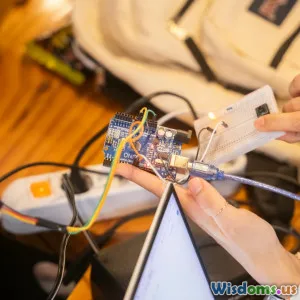
Personal Lessons from Auditing My Own Ethereum Smart Contracts
8 min read Discover practical insights and strategies from personally auditing Ethereum smart contracts to enhance security and reliability. (0 Reviews)
Personal Lessons from Auditing My Own Ethereum Smart Contracts
Introduction
Smart contracts on Ethereum have revolutionized decentralized applications by enabling trustless interactions backed by immutable code. However, this immutability comes with enormous responsibility — an error in a deployed contract can lead to irreversible losses, frozen assets, or exploited vulnerabilities. This sobering reality became crystal clear to me when I audited my own Ethereum smart contracts.
Performing a thorough audit on code I personally wrote opened my eyes to subtle bugs I'd overlooked, inefficiencies I took for granted, and security pitfalls lurking in seemingly trivial design choices. In this article, I share an honest, detailed journey through my auditing process, revealing invaluable lessons, practical tools, and strategies you can implement to elevate the security and reliability of your Ethereum smart contracts — whether you’re a hobbyist or a professional developer.
Why Audit Your Own Smart Contracts?
Before diving into lessons learned, let's clarify the importance of auditing smart contracts, even if you authored them:
-
Immutable Deployment: Smart contracts are immutable once deployed. The cost of overlooked bugs can be catastrophic.
-
Pseudonymity of Interaction: Users can’t hold a developer accountable like traditional SaaS; trust is algorithmic.
-
Complex Interactions: Many contracts interact with external protocols, amplifying risk.
Auditing your own code is not a sign of mistrust in your skills; it’s an essential best practice to minimize vulnerabilities and confirm the intended logic is bulletproof.
Initial Surprises: The Challenge of Self-Auditing
Self-auditing differs significantly from auditing foreign codebases. Key challenges include:
- Cognitive Bias: Knowing the code too well can blind you to flaws.
- Routine Blind Spots: Familiar code patterns may become so routine that you miss their flaws.
- Scope Limitation: Tendency to focus only on ‘critical’ areas, overlooking peripheral modules.
For example, while reviewing one contract that handled token transfers, I initially overlooked a missing check for edge cases like integer overflows in minting functions. The bug was subtle as I trusted Solidity’s built-in checks but was reminded that compiler versions and configurations affect safety.
Lessons Learned From My Self-Audit
Lesson 1: Use Automated Tools but Don’t Rely Solely on Them
Automated static analysis and formal verification are lifelines. Tools I found invaluable included:
- Slither: Static analysis framework detecting common vulnerabilities.
- MythX: Cloud-based comprehensive vulnerability scanner.
- Echidna: Fuzz testing for invariant breaches.
Each tool flagged different issues — for instance, Slither highlighted uninitialized state variables, while MythX found potential reentrancy risks.
However, these tools sometimes generate false positives or miss logic bugs like improper access controls. Hence, combining automated scanning with manual inspection is critical.
Lesson 2: Manual Code Review is the Real Muscle
I systematically scanned contract modules line-by-line, focusing on:
- Access Control: Ensuring only authorized calls through modifiers and explicit checks.
- State Variables: Correct initialization and no unintended overwrites.
- External Calls: Preventing reentrancy and handling failed calls gracefully.
A memorable find was an improperly scoped onlyOwner modifier that was accidentally bypassed due to inheritance ordering — a nuanced bug only apparent to manual inspection.
Lesson 3: Embrace a Defense-in-Depth Strategy
Learning from industry incidents like The DAO hack, I realized that layering security is crucial.
For instance, implementing both automatic checks (ReentrancyGuard from OpenZeppelin) and manual guard clauses significantly decreases risks. Relying on a single safeguard often proves insufficient.
Lesson 4: Test Thoroughly with Realistic Scenarios
Unit tests alone are not enough. I extended my coverage to:
- Integration Testing: Contract interactions in complex transactions.
- Stress Testing: Edge cases like multiple simultaneous token transfers and boundary numeric inputs.
- Gas Usage Monitoring: Ensuring functions are cost-efficient.
For example, testing a decentralized exchange contract revealed high gas consumption in a price oracle update function requiring optimization.
Lesson 5: Write Clear, Auditable Code
Clear code is easier to audit. I learned to:
- Use descriptive variable/function names.
- Comment on design decisions explicitly.
- Split large functions into manageable, understandable chunks.
This practice helps both when auditing yourself under time pressure and when inviting external auditors later.
Practical Strategies to Implement Immediately
- Update Solidity Compiler Versions Regularly: Newer versions often include security upgrades.
- Incorporate OpenZeppelin Libraries: Battle-tested, standardized contract modules reduce risk.
- Leverage Continuous Integration Pipelines: Automate testing and scanning on every commit.
- Maintain Audit Documentation: Justify why each step was included or excluded to aid future reviews.
Highlighting Real-World Insights
Ethereum projects like Compound and Uniswap have openly shared audit reports highlighting critical security issues and mitigations. They emphasize community involvement and multiple audits before public release. Inspired by them, I realized the value of collaborative review beyond self-audits.
According to smart contract security firm ConsenSys Diligence, common vulnerabilities include integer overflow/underflow, reentrancy, and unchecked calls — many of which surfaced in my code until fixed.
Conclusion
Auditing your own Ethereum smart contracts is an indispensable yet challenging endeavor. My experience revealed that this practice not only uncovers hidden bugs and inefficiencies—it cultivates a deeper appreciation for security-first design principles essential for success in the decentralized space.
The biggest takeaway: combine automated tools, manual deep-dives, comprehensive testing, and clear coding standards. This layered approach fortifies contracts, safeguards assets, and ultimately fosters user trust.
As blockchain technology and tools evolve, so too should your auditing approaches. Whether you’re deploying a basic token or a complex decentralized finance protocol, audit with rigor and an inquisitive mind—the health of your smart contracts depends on it.
References
- Slither - Static Analysis Tool
- MythX Platform
- OpenZeppelin Contracts
- Ethereum The DAO Report
- ConsenSys Diligence Best Practices
About the author: A passionate Ethereum developer dedicated to building secure decentralized applications, constantly sharpening skills through code audits and community involvement.
Rate the Post
User Reviews
Other posts in Blockchain
Popular Posts















